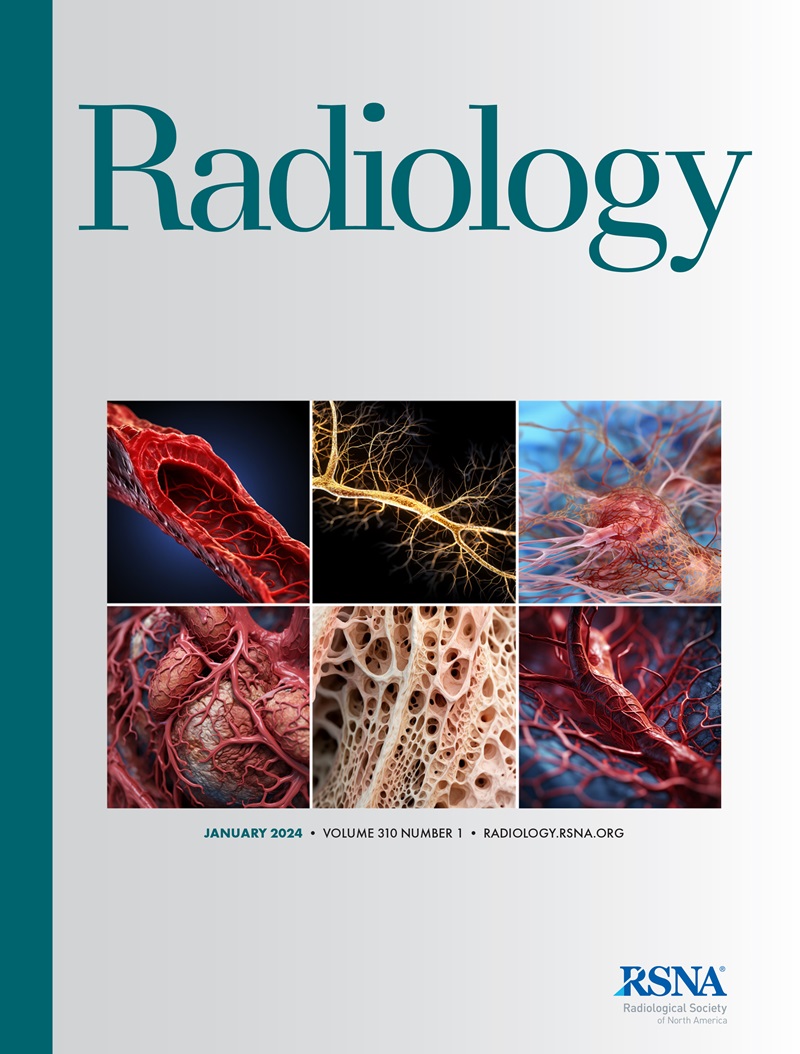求助PDF
{"title":"微波消融与射频消融治疗以实性为主的良性甲状腺结节:随机对照试验","authors":"Sitong Chen, Jianping Dou, Yuancheng Cang, Ying Che, Gang Dong, Chunlai Zhang, Dong Xu, Qinxian Long, Jie Yu, Ping Liang","doi":"10.1148/radiol.232162","DOIUrl":null,"url":null,"abstract":"<p><p>Background Current guidelines recommend radiofrequency ablation (RFA) as the first-line treatment for benign thyroid nodules. Purpose To compare the efficacy and safety of microwave ablation (MWA) and RFA for the treatment of predominantly solid benign thyroid nodules. Materials and Methods This prospective, randomized, open-label, multicenter study was conducted from August 2019 to February 2023. Participants with nonfunctioning, predominantly solid benign thyroid nodules from five institutions were randomly assigned with a 1:1 ratio to receive MWA or RFA treatment. Participants were followed up for at least 2 years. Primary outcomes were 6-month and 2-year volume reduction rate (VRR) of nodules after ablation. Secondary outcomes included VRR change over time, complications, and technique efficacy (defined as volumetric reduction ≥ 50% of the initial nodule volume). Continuous variables and categorical variables were compared using the <i>t</i> test and the χ<sup>2</sup> test or Fisher exact test, respectively. Results This study included 76 participants in the MWA group (mean age, 46 years ± 12 [SD]; 58 female participants) and 76 in the RFA group (mean age, 50 years ± 13; 56 female participants). MWA was noninferior to RFA in terms of 6-month (mean difference, -5.6%; <i>P</i> = .01) and 2-year (-2.4%; <i>P</i> < .001) VRR after ablation. Comparing MWA and RFA, no evidence of a difference was observed for VRR change over time (mean difference from mixed-effects analysis, 6.9% [95% CI: -0.5, 13.9]; <i>P</i> = .73) or technique efficacy (91% vs 86%; <i>P</i> = .40). The most common major complication was voice change, which occurred in 6.6% of participants in the MWA group and 1.3% of participants in the RFA group (<i>P</i> = .21). Conclusion MWA and RFA showed comparable efficacy for treating participants with predominantly solid benign thyroid nodules. However, a larger sample size is needed to demonstrate that safety is comparable between the procedures. ClinicalTrials.gov Identifier: NCT04046354 © RSNA, 2024 <i>Supplemental material is available for this article.</i> See also the editorial by McGahan in this issue.</p>","PeriodicalId":20896,"journal":{"name":"Radiology","volume":"313 1","pages":"e232162"},"PeriodicalIF":12.1000,"publicationDate":"2024-10-01","publicationTypes":"Journal Article","fieldsOfStudy":null,"isOpenAccess":false,"openAccessPdf":"","citationCount":"0","resultStr":"{\"title\":\"Microwave versus Radiofrequency Ablation in Treating Predominantly Solid Benign Thyroid Nodules: A Randomized Controlled Trial.\",\"authors\":\"Sitong Chen, Jianping Dou, Yuancheng Cang, Ying Che, Gang Dong, Chunlai Zhang, Dong Xu, Qinxian Long, Jie Yu, Ping Liang\",\"doi\":\"10.1148/radiol.232162\",\"DOIUrl\":null,\"url\":null,\"abstract\":\"<p><p>Background Current guidelines recommend radiofrequency ablation (RFA) as the first-line treatment for benign thyroid nodules. Purpose To compare the efficacy and safety of microwave ablation (MWA) and RFA for the treatment of predominantly solid benign thyroid nodules. Materials and Methods This prospective, randomized, open-label, multicenter study was conducted from August 2019 to February 2023. Participants with nonfunctioning, predominantly solid benign thyroid nodules from five institutions were randomly assigned with a 1:1 ratio to receive MWA or RFA treatment. Participants were followed up for at least 2 years. Primary outcomes were 6-month and 2-year volume reduction rate (VRR) of nodules after ablation. Secondary outcomes included VRR change over time, complications, and technique efficacy (defined as volumetric reduction ≥ 50% of the initial nodule volume). Continuous variables and categorical variables were compared using the <i>t</i> test and the χ<sup>2</sup> test or Fisher exact test, respectively. Results This study included 76 participants in the MWA group (mean age, 46 years ± 12 [SD]; 58 female participants) and 76 in the RFA group (mean age, 50 years ± 13; 56 female participants). MWA was noninferior to RFA in terms of 6-month (mean difference, -5.6%; <i>P</i> = .01) and 2-year (-2.4%; <i>P</i> < .001) VRR after ablation. Comparing MWA and RFA, no evidence of a difference was observed for VRR change over time (mean difference from mixed-effects analysis, 6.9% [95% CI: -0.5, 13.9]; <i>P</i> = .73) or technique efficacy (91% vs 86%; <i>P</i> = .40). The most common major complication was voice change, which occurred in 6.6% of participants in the MWA group and 1.3% of participants in the RFA group (<i>P</i> = .21). Conclusion MWA and RFA showed comparable efficacy for treating participants with predominantly solid benign thyroid nodules. However, a larger sample size is needed to demonstrate that safety is comparable between the procedures. ClinicalTrials.gov Identifier: NCT04046354 © RSNA, 2024 <i>Supplemental material is available for this article.</i> See also the editorial by McGahan in this issue.</p>\",\"PeriodicalId\":20896,\"journal\":{\"name\":\"Radiology\",\"volume\":\"313 1\",\"pages\":\"e232162\"},\"PeriodicalIF\":12.1000,\"publicationDate\":\"2024-10-01\",\"publicationTypes\":\"Journal Article\",\"fieldsOfStudy\":null,\"isOpenAccess\":false,\"openAccessPdf\":\"\",\"citationCount\":\"0\",\"resultStr\":null,\"platform\":\"Semanticscholar\",\"paperid\":null,\"PeriodicalName\":\"Radiology\",\"FirstCategoryId\":\"3\",\"ListUrlMain\":\"https://doi.org/10.1148/radiol.232162\",\"RegionNum\":1,\"RegionCategory\":\"医学\",\"ArticlePicture\":[],\"TitleCN\":null,\"AbstractTextCN\":null,\"PMCID\":null,\"EPubDate\":\"\",\"PubModel\":\"\",\"JCR\":\"Q1\",\"JCRName\":\"RADIOLOGY, NUCLEAR MEDICINE & MEDICAL IMAGING\",\"Score\":null,\"Total\":0}","platform":"Semanticscholar","paperid":null,"PeriodicalName":"Radiology","FirstCategoryId":"3","ListUrlMain":"https://doi.org/10.1148/radiol.232162","RegionNum":1,"RegionCategory":"医学","ArticlePicture":[],"TitleCN":null,"AbstractTextCN":null,"PMCID":null,"EPubDate":"","PubModel":"","JCR":"Q1","JCRName":"RADIOLOGY, NUCLEAR MEDICINE & MEDICAL IMAGING","Score":null,"Total":0}
引用次数: 0
引用
批量引用


